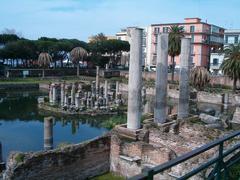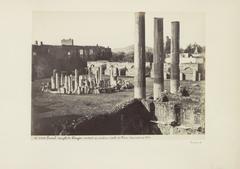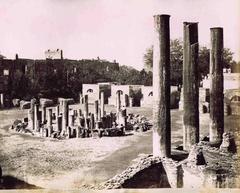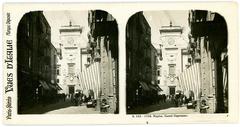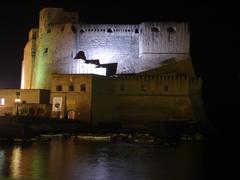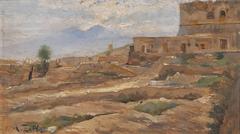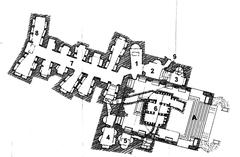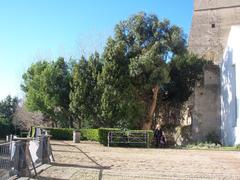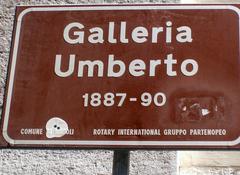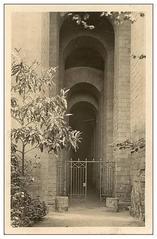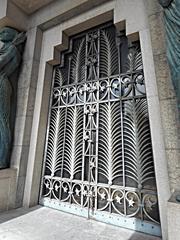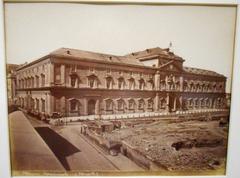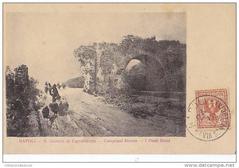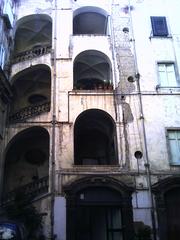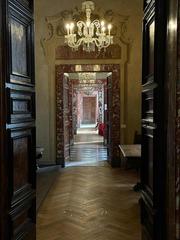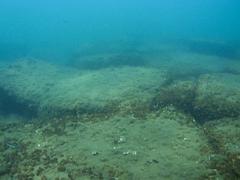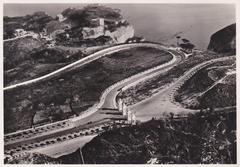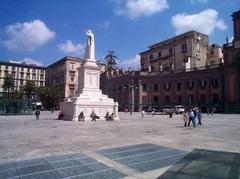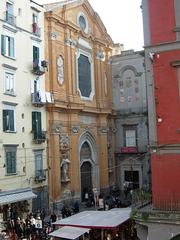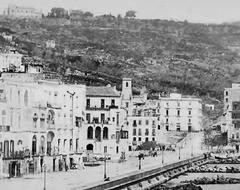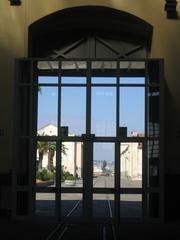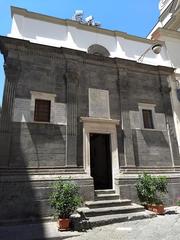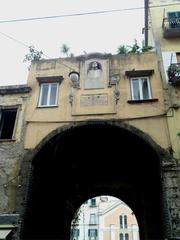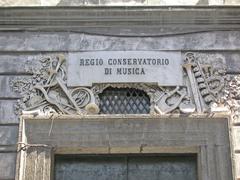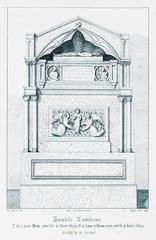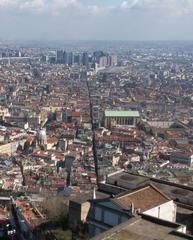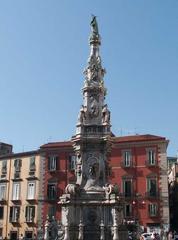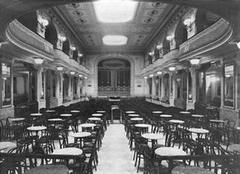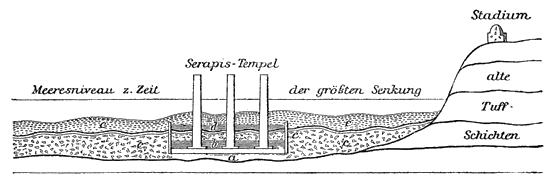
Visiting Macellum Tempio di Serapide: A Complete Guide to Naples’ Historical Gem
Date: 23/07/2024
Introduction
Explore the fascinating history and architectural grandeur of the Macellum Tempio di Serapide in Pozzuoli, Italy. Steeped in rich historical significance, this ancient Roman marketplace offers a captivating journey through time for visitors. Originally constructed in the 1st century AD during the reign of Emperor Domitian, the Macellum Tempio di Serapide was initially misidentified as a temple dedicated to the Egyptian god Serapis due to the discovery of a statue of the deity on the site (Italy Heaven). However, subsequent archaeological studies revealed that it was indeed a macellum, a bustling marketplace central to Roman commerce and social life.
The Macellum is renowned not only for its historical significance but also for its impressive architectural design, which includes a large central courtyard surrounded by a colonnade of cipollino marble columns, a greenish stone quarried in Greece that underscores the trade connections and wealth of the Roman Empire (Rome Art Lover). Additionally, the site serves as a natural gauge for the phenomenon of bradyseism, the gradual uplift and subsidence of the Earth’s surface due to volcanic activity, providing invaluable insights into the volcanic activity of the Phlegraean Fields (Naples LDM).
This comprehensive guide will provide all the essential information you need to make the most of your visit, including visitor hours, ticket prices, travel tips, and the site’s cultural significance. Whether you’re a history enthusiast, an architecture aficionado, or simply looking for a unique travel experience, the Macellum Tempio di Serapide promises to be a remarkable journey into the past.
Table of Contents
- Introduction
- Historical Background of Macellum Tempio di Serapide
- Visitor Information
- Cultural and Economic Hub
- Modern-Day Significance
- Visitor Experience
- Conclusion
- FAQ
Historical Background of Macellum Tempio di Serapide
Ancient Origins
The Macellum Tempio di Serapide, located in the heart of Pozzuoli, Naples, Italy, is a significant archaeological site that dates back to the Roman era. The structure was originally constructed in the 1st century AD during the reign of Emperor Domitian. It served as a macellum, or marketplace, which was a central feature in Roman cities. The name “Tempio di Serapide” is somewhat of a misnomer, as it was mistakenly believed to be a temple dedicated to the Egyptian god Serapis due to the discovery of a statue of the deity on the site (Italy Heaven).
Architectural Significance
The Macellum is renowned for its impressive architectural design, which includes a large central courtyard surrounded by a colonnade. The courtyard was originally paved with marble and featured a tholos, a circular building that likely served as a shrine or a place for important market transactions. The columns of the Macellum are particularly noteworthy; they are made of cipollino marble, a greenish stone quarried in Greece, which underscores the trade connections and wealth of the Roman Empire (Rome Art Lover).
Geological Phenomena
One of the most fascinating aspects of the Macellum Tempio di Serapide is its role as a natural gauge for the phenomenon of bradyseism, the gradual uplift and subsidence of the Earth’s surface due to volcanic activity. The columns of the Macellum bear visible marks of marine organisms, indicating periods when the structure was submerged underwater. This cyclical rise and fall of the ground level has been meticulously documented since the 18th century and provides valuable insights into the volcanic activity of the Phlegraean Fields (Naples LDM).
Rediscovery and Excavation
The site was rediscovered in the 18th century during the Bourbon rule of Naples. Initial excavations were carried out under the direction of King Charles of Bourbon, who was keenly interested in the ancient ruins of his kingdom. These early excavations revealed the extent of the marketplace and led to the identification of the structure as a macellum. Subsequent archaeological efforts in the 19th and 20th centuries have further uncovered the layout and details of the site, including the discovery of various artifacts such as pottery, coins, and statues (Britannica).
Visitor Information
Ticket Prices and Opening Hours
The Macellum Tempio di Serapide is open daily from 9 AM to 7 PM. Tickets are priced at €10 for adults and €5 for children. For the latest hours and any changes, visit the official Naples tourism website.
Travel Tips
The site is easily accessible by public transport, with several bus and train routes stopping nearby. Parking is available for those driving. Visitors should wear comfortable walking shoes, as the site involves a fair amount of walking and uneven terrain. Sunscreen, hats, and water are essential, especially during the summer months when temperatures can be high.
Guided Tours and Special Events
Guided tours are available in multiple languages. Check the official website for information on special events and exhibitions. Booking in advance is recommended, especially during peak tourist seasons.
Cultural and Economic Hub
Decline and Transformation
In its heyday, the Macellum Tempio di Serapide was a bustling center of commerce and social interaction. It was strategically located near the port of Pozzuoli, which was one of the most important harbors in the Roman Empire. The marketplace would have been filled with vendors selling a variety of goods, including fresh produce, meats, fish, and imported luxuries. The presence of the tholos suggests that the market also had a religious or ceremonial function, possibly related to the worship of local deities or the imperial cult (Ancient History Encyclopedia).
The decline of the Roman Empire in the 5th century AD led to the gradual abandonment of the Macellum. The site fell into disrepair and was eventually buried under layers of sediment and volcanic ash. During the medieval period, the area was repurposed for various uses, including as a quarry for building materials. The transformation of the site over the centuries reflects the broader changes in the region’s social and economic landscape (Livius).
Modern-Day Significance
Key Discoveries and Artifacts
Among the most significant discoveries at the Macellum are the statues and inscriptions that provide insights into the religious and cultural practices of the time. The statue of Serapis, which led to the site’s misidentification as a temple, is a prime example. Other notable finds include inscriptions dedicated to various deities and imperial figures, as well as everyday items like pottery and tools that offer a glimpse into the daily lives of the market’s patrons and vendors (Italy Heaven).
Preservation Efforts
Preservation of the Macellum Tempio di Serapide is an ongoing challenge due to the site’s exposure to natural elements and the effects of bradyseism. Conservation efforts have focused on stabilizing the remaining structures and protecting the site from further damage. These efforts are supported by both local and international organizations dedicated to preserving cultural heritage. Advances in technology, such as 3D scanning and digital modeling, are also being utilized to document and study the site in greater detail (Rome Art Lover).
Visitor Experience
For visitors, the Macellum Tempio di Serapide offers a unique opportunity to step back in time and experience the grandeur of ancient Roman architecture. Informative plaques and guided tours provide context and historical background, enhancing the visitor experience. The site’s proximity to other attractions in Pozzuoli, such as the Flavian Amphitheater and the Solfatara crater, makes it an essential stop on any tour of the region (Naples LDM).
Conclusion
The Macellum Tempio di Serapide stands as a testament to the architectural ingenuity and economic vitality of ancient Rome. From its origins as a bustling marketplace to its role in documenting the phenomenon of bradyseism, this site offers a multifaceted glimpse into the past. The rediscovery and excavation efforts over the centuries have unearthed a wealth of artifacts, including statues, inscriptions, and everyday items, providing valuable insights into the daily lives of ancient Romans (Britannica).
Today, the Macellum Tempio di Serapide continues to attract visitors from around the world, eager to explore its ruins and learn about its rich history. Efforts to preserve and protect the site are ongoing, ensuring that future generations can appreciate this remarkable link to the past. Visitors are encouraged to take guided tours to gain a deeper understanding of the site’s historical and architectural significance and to explore nearby attractions such as the Flavian Amphitheater and the Solfatara crater for a more comprehensive experience of the region (Ancient History Encyclopedia).
By visiting the Macellum Tempio di Serapide, you’ll gain a profound appreciation for the rich history and cultural heritage of ancient Rome. Don’t miss out on this unique opportunity to step back in time and explore one of Pozzuoli’s most significant historical sites.
FAQ
What are the visiting hours for Macellum Tempio di Serapide?
- The site is typically open from 9 AM to 7 PM. Check the official website or contact the local tourist office for the most current information.
How much are tickets to Macellum Tempio di Serapide?
- Tickets cost €10 for adults and €5 for children.
Are guided tours available?
- Yes, guided tours are available and highly recommended for those interested in a deeper understanding of the site’s history and significance.
Is the site accessible for visitors with mobility issues?
- The site is partially accessible. It is advisable to contact the site in advance to inquire about specific accessibility arrangements and facilities.
References
- Italy Heaven (n.d.). Retrieved from https://www.italyheaven.co.uk/campania/pozzuoli.html
- Rome Art Lover (n.d.). Retrieved from https://www.romeartlover.it/Pozzuoli.html
- Naples LDM (n.d.). Retrieved from https://www.naplesldm.com/serapide.php
- Britannica (n.d.). Serapeum of Pozzuoli. Retrieved from https://www.britannica.com/place/Serapeum-of-Pozzuoli
- Ancient History Encyclopedia (n.d.). The Macellum of Pozzuoli. Retrieved from https://www.ancient.eu/article/1154/the-macellum-of-pozzouli/

